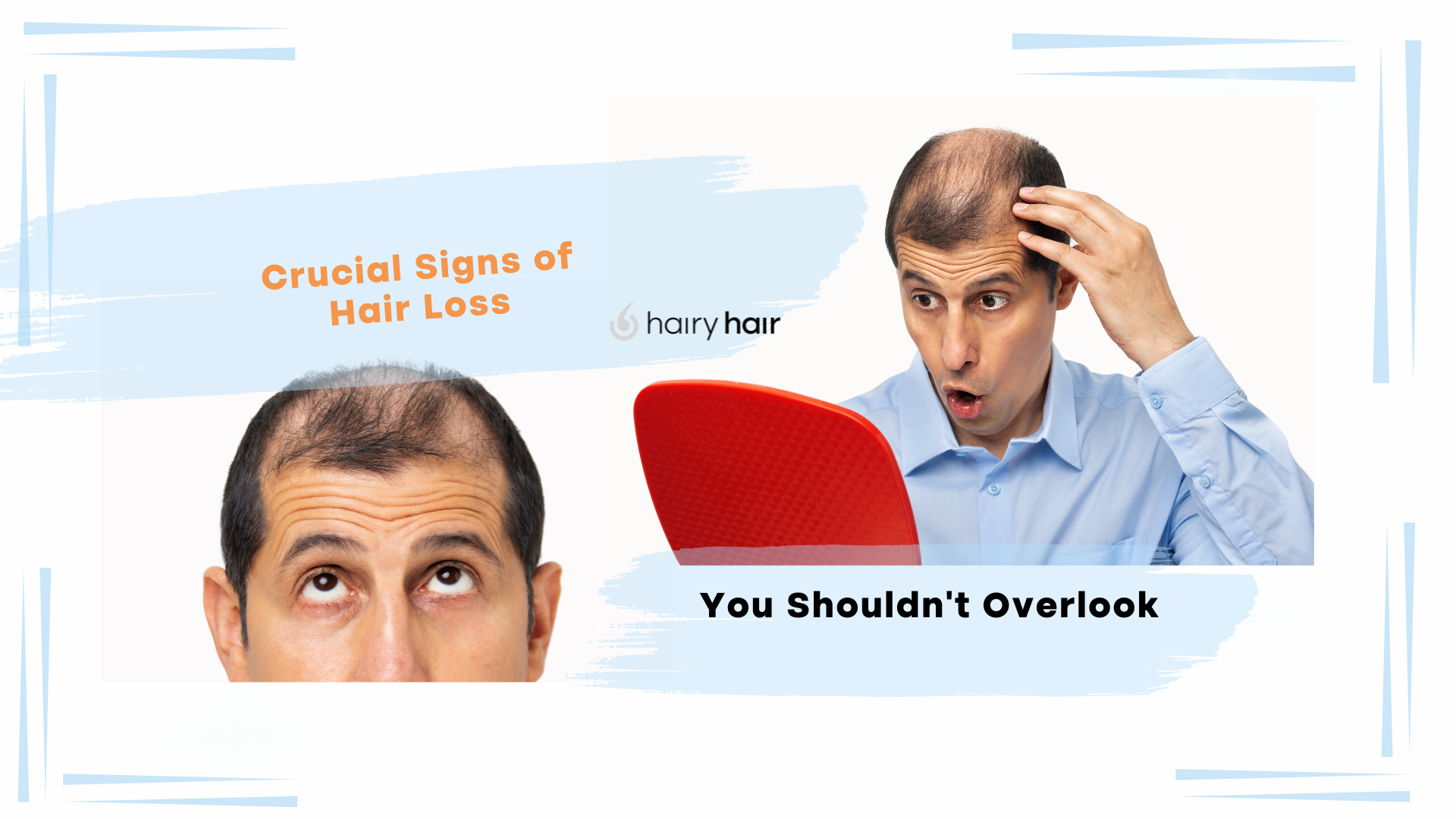Crucial Signs of Hair Loss You Shouldn’t Overlook

While you may already be worried about hair loss if it runs in the family, it can be difficult to identify when it’s happening. Taking action as early as possible will give you the best chances to fight your hair loss and prevent further hair loss.
Here we will look at the most common signs of hair loss you should look out for. We’ll also cover the primary reasons for hair loss as well as preventative measures you can take and the treatment options you should consider. If you’re concerned about your hair loss we’ll also share how Hairy Hair may help you to act fast when you see the first signs of hair loss.
- Understanding hair loss
- What are the most common signs of hair loss?
- What are the causes and risk factors of hair loss?
- What are the prevention and treatment options for hair loss?
- What can Hairy Hair do to help my hair loss?
- When should you seek medical attention?
- Final thoughts
Understanding hair loss
Hair loss, also known as alopecia, can be temporary or permanent, affecting the scalp or entire body.
It’s essential to understand the causes and signs of hair loss to seek proper treatment.
Hair loss can be a normal part of aging, but it can also be caused by medical conditions or hormonal changes.
[elementor-template id=”9678″]
What are the most common signs of hair loss?
Thinning hair
If you are losing hair faster than it has a chance to grow, it can result in thinning hair. This is a symptom of a change in the hair growth cycle.
Over time, the gradual thinning of hair can lead to baldness, but some treatments can stop hair loss in its tracks and bring back lost thickness.
Thinning hair can be a sign of female or male pattern hair loss too, also known as androgenetic alopecia.
It’s essential to consult a specialist hair loss doctor to determine the cause of thinning hair.
Bald patches
Alopecia areata is an autoimmune reaction that manifests as bald patches on the scalp that are usually the size of a coin and can appear all over the scalp.
Contact your GP or a dermatologist if you notice any bald patches on your scalp to receive a medical diagnosis along with treatment advice.
Bald patches can also be a sign of other medical conditions, such as ringworm of the scalp or traction alopecia where the hair falls out due to tight hairstyles.
Excessive hair shedding
Excessive hair shedding is a common sign of hair loss, especially during seasonal changes or hormonal imbalances.
Losing more than 100 hairs a day can be a sign of hair loss, and it’s essential to consult a doctor to determine the cause.
Excessive hair shedding can be a sign of temporary hair loss, but it can also be a sign of underlying medical conditions.
What are the causes and risk factors of hair loss?
Genetics and hormonal imbalances
Genetics play a significant role in how hair loss occurs, with hereditary hair loss being the most common cause.
Hormonal imbalances, such as those experienced during menopause or pregnancy, can also cause hair loss.
Pattern hair loss is often caused by hormonal imbalances, leading to thinning hair and hair loss.
Telogen effluvium is a type of sudden hair loss that results from emotional or physical shock.
Medical conditions
Certain medical conditions, such as thyroid disease, autoimmune disorders, and skin conditions, can cause hair loss.
Hair loss can also be a side effect of some medications, especially chemotherapy medications to treat cancers. Anagen effluvium involves a rapid loss of hair, typically due to radiation treatment or chemotherapy.
It’s essential to consult a doctor to determine the underlying cause of hair loss.
What are the prevention and treatment options for hair loss?
Prevention
Most baldness is caused by genetics (male-pattern baldness and female-pattern baldness), which is not preventable. You can take steps to minimise the progression of this kind of hair loss through medications or other hair growth treatments.
However, some tips may help you avoid preventable types of hair loss, such as using a gentle shampoo and avoiding heated styling tools.
Maintaining a healthy diet and reducing stress can also help prevent hair loss.
Treatment options
Treatment options for hair loss depend on the underlying cause, which may include hair loss due to genetics, hormonal changes, stress, or other factors. Topical or oral medications are typically the first course of treatment for hair loss.
The most common topical medications for hair loss often contain the ingredient minoxidil. Minoxidil is available over the counter as a treatment for hair loss. Prescription medications like finasteride may help prevent further androgenetic hair loss.
Treatment options may include light therapy which is a non-invasive treatment to stimulate hair growth on the scalp.
Hair transplant surgery involves extracting healthy hair from a donor site on your hair and implanting it into balding or thinning areas. Hair transplant surgery can provide permanent results for hair loss. The hair surrounding the recipient site will continue to be affected by progressive hair loss however, so it is best suited for those whose hair loss has stabilised.
[elementor-template id=”9673″]
What can Hairy Hair do to help my hair loss?
If you’ve noticed thinning, bald patches or excessive hair fall, it’s time to look for a solution to prevent further hair loss. Hairy Hair provides a comprehensive hair growth treatment that may cover different causes of hair loss.
Our formulation contains a dihydrotestosterone (DHT) blocker that may prevent the miniaturisation of hair follicles and a vasodilator that can widen blood vessels to allow for more nutrients to reach the damaged hair follicle strands.
Natural growth promoters which are included may help to provide the ideal environment for new hair growth on your scalp. By using ingredients that tackle different hair loss issues, you can give yourself the potential to regain lost hair and prevent further hair loss.
How does it work?
It all starts with a quick online questionnaire. Here we’ll get to know you and your hair loss to design a personalised treatment plan. One of our qualified Australian GPs will then get in touch to discuss your Hairy Hair pill and address any questions you may have. Then your prescription will be delivered to your door. With no clinic visits required, you can combat your hair loss all from the comfort of your home.
When should you seek medical attention?
If you’re experiencing persistent hair loss and want to pursue treatment, see a doctor. Hair loss can be incredibly distressing and can affect self-esteem.
Talk to a doctor if you notice sudden or patchy hair loss, as this can signal an underlying medical condition.
Consult a doctor if you’re experiencing more than usual hair loss when combing or washing your hair.
Conclusion
Understanding when to act on your hair falling out requires looking out for the first signs of hair loss. If you start to notice your hair thinning, bald patches or excessive hair loss you should tackle the problem as soon as possible.
When you know the cause of your hair loss, it’s easier to address the issue and choose the right treatment for you. Get in touch with Hairy Hair today to discuss your potential hair regrowth journey through dedicated support. Our prescription provides a convenient and discreet option to help possibly treat hair loss and give your hair the potential to grow.
In This Article
Overview
Most Trending Articles


